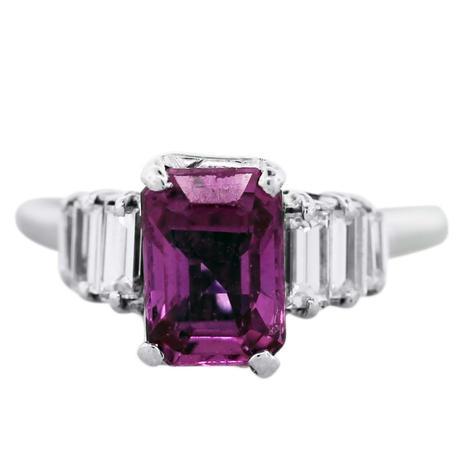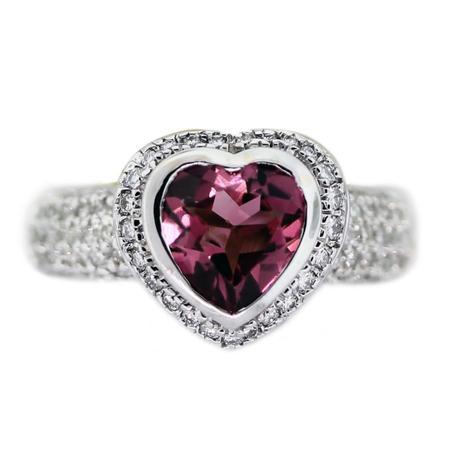Tourmaline is a semi-precious stone that comes in multiple colors. It has the widest variety of color of all the gemstones. There are shades of every hue in the spectrum. It is a crystal boron silicate mineral, and contains aluminum, potassium, iron, lithium, magnesium and sodium.
HISTORY
In the 16th century, a Spanish adventurer found what he thought was a beautiful bright green emerald while exploring in Brazil. It wasn’t until the 19th century that scientists realized that this stone was in fact not an emerald, but was a different mineral species completely. The name “tourmaline” is derived from the word “taramalli” which is translated as “mixed gems” from the language Sinhalese in Sri Lanka.

18k White Gold Pink Tourmaline and Emerald Cut Diamond Ring
This term was then applied to these multicolored pebbles, eroded by water that miners found in the Sri Lanka gem gravels. There is a possibility that people had been using and wearing tourmaline for hundreds of years, but had assumed it was another gemstone in error. Some tourmaline stones can closely resemble rubies, sapphires and emeralds.
There are no other gems that can compare to tourmaline’s array of rich colors. There are reds, pastel pinks, peach colors, emerald greens, vivid yellows and deep blues. More intense colors were discovered in the late 20th century in Brazil.
In the US, tourmaline was unheard of until 1892. This is when the gem became better known as an American gemstone because of the infamous George F. Kunz, a gemologist for Tiffany’s. He was most impressed by the tourmaline found in California and Maine. A large portion of the tourmaline from the US was exported to China, where there was a larger market for the stone.
In the early 20th century, Brazil began to find tourmaline in its mines. In the mid 1900’s, many countries around the world, including Afghanistan and Madagascar started yielding great quantities of the unusual gemstone. Some of the largest producing mines in the US today are the Tourmaline Queen, Tourmaline King, Stewart, Pala Chief and Himalaya, all within San Diego County.
VARIETIES

18k White Gold 1ct Diamond Pink Tourmaline Heart Ring
There are many different varieties of tourmaline, depending on their significant color. The pink, red, purple-red, orange-red and brown-red tourmaline is called Rubellite. The dark violet-blue, blue and green tourmaline is Indicolite. The intense violet-blue, green-blue and blue tourmaline from Paraiba, Brazil is called Paraiba tourmaline. Chrome tourmaline is a bright green and contains quite a bit of vanadium which is the same element that is in Brazilian and African emeralds. A tourmaline that contains multiple colors is called a parti-colored tourmaline, and one of main combinations of colors is green and pink, although it isn’t uncommon to see other color combinations. Tourmaline that is pink in the center and green around the outside is called watermelon tourmaline.
Some of the tourmaline stones contain the cat’s-eye effect, which is technically called chatoyancy. These are most often pink, blue or green. This stone isn’t as sharp as a regular gemstone, but instead have to be cut in order to show off this effect.
Tourmaline is divided up into species. The major species are elbaite, liddicoatite, dravite, uvite and schorl. The colors of the gemstones are formed because of a number of different factors. Usually, there is iron found in the stone formation, and possible titanium. These are thought to form greenish and bluish colors within the stone. Manganese is thought to make more of the reds and pinks. Some of the yellow hues can be caused by natural or simulated radiation.

